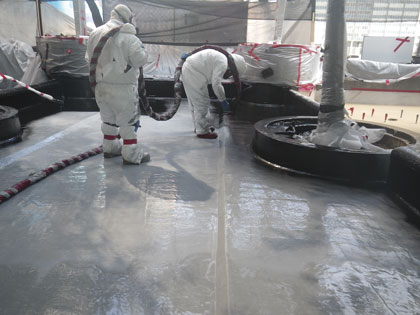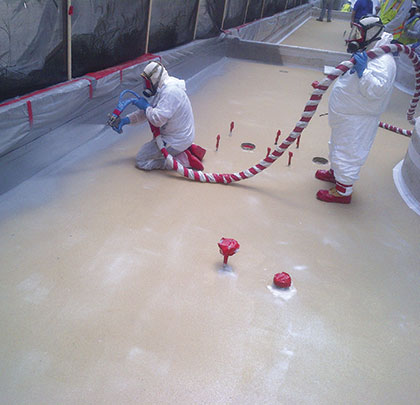Fountain Place in Dallas, Texas, is an architectural wonder known for its “dancing” water gardens at the base of a dramatically sculpted office tower of reflective glass designed by I.M. Pei. However, when it was time for its famed water features to be renovated, the building’s ownership group and primary engineer wanted to be confident that the restoration would be leak proof well beyond the waterproofing materials used in its original construction.
While Fountain Place has always been structurally sound, the water garden renovation was complicated by a couple of factors, according to Gary Bennett, Fountain Place’s ownership group representative.
“The water gardens were originally constructed above a parking garage with thousands of concrete cold joints, using separate pours not really designed to be waterproof,” says Bennett. “The vertical to horizontal concrete components were sealed with various waterproofing products that were not completely designed for the condition in how they were used.”
As a solution, they turned to a new breed of seamless, flexible coatings that, used in combination, are designed to prevent water leakage, provide chemical and UV resistance, and enhance aesthetics for decades.
KEEPING AN OASIS WATERTIGHT
The Fountain Place renovation project consists of nearly two acres of cascading waterfalls, pools, fountains, and elevated walkway pavers, according to John Pierce, executive vice president at Mobile Enterprises, a specialty commercial architectural and structural contractor. Mobile Enterprises is responsible for restoring the water gardens including concrete repair, waterproofing, and paver replacement for the entire project.
According to Pierce, elastomeric coatings had been primarily used to waterproof Fountain Place’s water features. However, these had deteriorated over time, leading to water leaking into the parking garage below.
“The original design used polyurethane based elastomeric coatings over 20 years ago,” says Pierce. “While these have UV resistant topcoats, over time exposure to chlorine in the water as well as outdoor UV rays begin to bake those membranes. They become soft and chalky. They wear out, become susceptible to substrate movement, and prone to leaks.”
LOCATION PRESENTS CHALLENGE
Beyond this, the location of the water features presented additional challenges. “The fountains are built over a concrete parking structure that is moving as cars drive around looking for spaces,” says Pierce. “The parking deck’s top slab is made up of pre-cast planks with a topping slab. Because of this, there is movement in the garage structure.”
Pierce says that any water feature waterproofing must also accommodate daily and seasonal temperature changes, since this can cause concrete substrate movement, leading to leakage over time too.
“Mid-Texas summers are hot and winters are cold,” says Pierce. “This will cause water feature concrete expansion as higher temperature water flows over it in summer and contraction as colder water flows over it in winter. Thermal cycling between day and night can also cause some substrate movement as well.”
According to Bennett, all the substrate movement was well beyond the original waterproofing products’ capability to maintain constant waterproofing. Despite these challenges, any waterproofing used in Fountain Place’s renovation had to endure concrete substrate movement and still not leak.

Featured Image: After completing necessary concrete repairs and priming water feature areas, the company sprayed a 60 mil basecoat of VersaFlex FSS 45DC or waterproofing.
Above: Mobile Enterprises sprayed a 20 mil topcoat of GelFlex, an aliphatic chemical resistant, UV color stable, 100 percent solids, polyurea topcoat.
DEALING WITH THE SUBSTRATE
Pierce says that some of the Fountain Place’s pools above the parking garage had been remediated with a PVC roofing membrane with heat welded seams, but still had leakage issues.
“Most waterproofing materials with heat welded seams must remain fully adhered to the substrate,” says Pierce. “However, moisture in the concrete can diminish the membrane’s adhesion, leading to gaps and water leakage. This is one reason that a seamless system is often preferred over a seamed system.”
Pierce says that many traditional materials would also not be up to the task of waterproofing. “Materials like plaster, epoxy, or tile would need to have an underlying elastomeric membrane to function because anything rigid would crack and leak,” he says. “Being constantly submerged and not being chemical resistant can also cause problems to the underlying membranes.”
Instead of less durable coatings and traditional pool membranes, Fountain Place’s ownership group and primary engineer selected an elastomeric polyurea basecoat and topcoat combination from VersaFlex, a global supplier of high-performance polyurea coatings, liners, and joint sealants for a wide variety of architectural design environments.
WATERPROOFING SOLUTION
As part of Fountain Place’s restoration, Mobile Enterprises removed water feature materials down to the original structure, as well as paver stones in plaza area walkways.
After completing necessary concrete repairs and priming water feature areas, the company sprayed a 60 mil basecoat of VersaFlex FSS 45DC or waterproofing.
“The polyurea basecoat provides a seamless, flexible, waterproof membrane system,” says Pierce. “It is flexible enough to accommodate structural garage movement, ground movement, as well as daily or seasonal expansion or contraction due to temperature changes. Anytime you deal with concrete, you deal with cracks, so its crack bridging properties are also important.”
On top of this, Mobile Enterprises sprayed a 20 mil topcoat of GelFlex, an aliphatic chemical resistant, UV color stable, 100 percent solids, polyurea topcoat.
Together, the polyurea basecoat and topcoat “provide a much tougher, more aesthetic membrane for the long haul than other softer elastomeric coatings,” adds Pierce, who also reinstalled an elevated paver pedestal system at Fountain Place by Wausau. ■
Editor’s Note: Spraying of the polyurea basecoat and topcoat is achieved with a plural component spray gun connected to a long heated hose and pump machine. Unlike a traditional two-part epoxy topcoat with a short pot life, the polyurea products’ components are mixed in the spray gun nozzle during application so there is no pre-mixing needed and essentially no waste in the process.
About the Author: Del Williams is a technical writer based in Torrance, California. To watch an application video or get more information about VersaFlex, visit www.versaflex.com.
_________________________________________________________________________
Modern Contractor Solutions, June 2017
Did you enjoy this article?
Subscribe to the FREE Digital Edition of Modern Contractor Solutions magazine.

Ensuring Urban Oasis Remains Watertight


